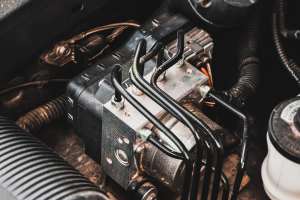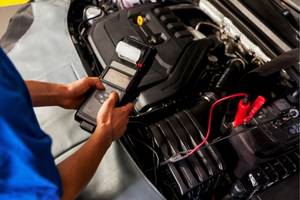Introduction
Car troubles can be difficult, especially when they involve complex components like the engine control module (ECM). But don't worry! This guide is here to simplify the process and help you understand everything about ECM repair. Whether you're a seasoned DIYer or a car owner looking to learn more, we've got you covered. Ready to dive in? Le's get started!
1. Identify symptoms of a faulty Engine Control Module (ECM)
With engine control module issues, it's all about recognizing the signs before they accelerate into bigger problems. Your car's ECM, sometimes referred to as the car's "brain", is responsible for controlling various engine functions. If it's on the blink, your ride might be giving you some signals. Let's explore some telltale symptoms:
Stalling or Misfiring: If your car randomly stalls or misfires, it could be your ECM sending out an SOS. It's trying to tell you, "Hey, I need some engine control module repair!"
Decreased Fuel Efficiency: Notice you're burning through fuel faster than usual? An underperforming ECM can cause a decrease in fuel efficiency.
Check Engine Light: This one's a no-brainer! If your check engine light turns on, it's time to check your engine control module. After all, it takes more than a little car hiccup to bring this light to life.
Difficulties in Starting the Car: You might have ECM issues if you're breaking a sweat trying to start the car. It's not your muscles; it's your engine control module needing repair.
Unusual Engine Behavior: Unpredictable shifts? Random RPM (Revolutions Per Minute) fluctuations? Your ECM is likely asking for some TLC.
If your car is throwing these curveballs at you, it's time to consider engine control module repair. Remember, an early diagnosis can save you from the headaches of costly repairs down the road.
In the next section, we'll dive into some techniques for diagnosing ECM problems. Stay tuned, because it's about to get technical!
2. Diagnose ECM problems with these techniques
I'm sure you're eager to get your hands dirty and dive into some engine control module repair. But before we get carried away with the tools, let's take a moment to figure out how to diagnose those annoying ECM problems. It's like solving a mystery, and you're the detective!
Diagnostic Trouble Codes (DTCs): This should be your first stop in your journey of engine control module repair. With a reliable OBD2 (On-Board Diagnostics) scanner, you can decode the DTCs. These codes will give you a clear snapshot of what's going wrong.
Voltage Checks: Grab that multimeter and check the ECM power circuits. If the voltages are off, your ECM might be waving a white flag.
Visual Inspection: Yes, it can be as simple as a visual check! Look for any signs of damage or corrosion in the ECM. Sometimes, the problem is literally on the surface.
Signal Tests: The ECM communicates with the rest of your car. So, it's a good idea to check if all the signals are coming through. Any missing signals could point to a faulty ECM.
Professional Diagnosis: While DIY is fun, sometimes you need to call in the pros. An experienced mechanic can run a thorough diagnosis and confirm if you need engine control module repair.
Remember, the key to a successful repair is a detailed diagnosis. With these techniques, you'll be well on your way to solving your ECM mystery. Next up, we'll tackle the big question: repair or replace? Don't go anywhere; we're just getting started!
3. Repair or replace? Weigh your options
So, you've done your detective work and confirmed that your ECM is acting up. The next step in your engine control module repair journey is to decide: repair or replace?
That's a tough question, isn't it? But don't worry, we'll break it down.
The Case for Repair
Repairing your ECM can be a good option when:
The problem is minor, like a small glitch or a loose wire. In such cases, a quick fix might be all you need.
Budget is a concern. Repairing an ECM can be a cost-effective solution if you're looking to save some cash.
You have the right skills and tools. If you know your way around a toolbox and have a knack for electronics, you might enjoy the challenge!
The Case for Replacement
On the flip side, replacing your ECM could be the best route if:
The damage is large. If your ECM is fried or corroded beyond repair, it's time to say goodbye.
You want a guarantee. A new ECM comes with a warranty, giving you peace of mind.
You prefer a hassle-free solution. Though it could be costlier, replacing your ECM is typically quicker and easier than repairing it.
Choosing between repair and replacement isn't always easy, but with these points in mind, you're better equipped to make an informed decision.
In the next section, we'll guide you through the steps of engine control module repair. Get your toolbox ready; we're about to get technical!
4. Step-by-step guide to ECM repair
Alright, you've weighed your options and decided on the repair route. So, let's dive right into the step-by-step process of engine control module repair. Remember, patience and precision are key here!
Safety First!
Before you begin, disconnect the battery's negative terminal. We don't want any surprise shocks, do we?
Step 1: Locate the ECM
The first task is to find the ECM. It's typically located in the engine's compartment or under the dashboard. Once found, use your owner’s manual to ensure you've got the right part.
Step 2: Remove the ECM
Next, carefully remove the ECM from its location. Use a suitable wrench to loosen the bolts securing it. Remember, we're going for careful, not hasty.
Step 3: Inspect the ECM
Now, inspect the ECM for visual signs of damage. Any burn marks, corrosion, or loose wires? If yes, then we're on the right track.
Step 4: Repair the ECM
Depending on the issue, you might need to solder loose wires, clean corrosion, or replace blown capacitors. Take your time, and make sure to do a thorough job.
Step 5: Test the ECM
Once the repairs are done, it's time to test the ECM. Reconnect it, start your car, and check if the previously identified symptoms still continuous. If not, you've just successfully completed your engine control module repair!
Now, isn't that something to be proud of?
Stay tuned for the final section, where we'll discuss how to maintain your ECM and prevent future problems. Because, let's face it, wouldn't it be nice to avoid this whole ordeal in the future?
5. Maintain your ECM to prevent future issues
Having gone through the process of engine control module repair, you know it isn't a walk in the park. Wouldn't it be great if we could sidestep these issues in the future? Well, you can! Let's talk about some ways to maintain your ECM.
Keep it clean!
One of the simplest and most effective measures is Keeping your ECM clean. A regular wipe down removes dust and debris that might lead to corrosion or loose connections. Simple, yet effective!
Regular Inspection
Schedule regular inspections of your ECM. Look for signs of wear and tear, loose wires, or burnt areas. Early detection can prevent minor issues from becoming major headaches.
Protect your ECM
Consider investing in covers or shields to protect the ECM from heat and water damage. Yes, it's an extra expense, but think of it as insurance against future repair costs.
Software Updates
Stay updated with the latest software for your ECM. These updates are designed to improve performance and fix known bugs. So, don't ignore those update notifications!
Professional Check-ups
Lastly, consider professional check-ups. A trained technician can catch potential issues you might miss, ensuring your ECM stays in top shape.
By following these steps, you can minimise the chance of needing another engine control module repair anytime soon. So, you can sit back, relax, and enjoy the ride. Because isn't that what driving should be all about?
Conclusion
Understanding and addressing ECM issues might seem overwhelming at first, but with the right knowledge and approach, it's entirely manageable. By identifying symptoms early, diagnosing problems accurately, and deciding whether to repair or replace, you can keep your car running smoothly. Regular maintenance and professional check-ups will also go a long way in preventing future issues. So, keep these tips in mind, and you'll be well-prepared to handle any ECM challenges that come your way. Safe driving!
FAQs on
Comprehensive Guide to Engine Control Module Repair in 2025 : Tips and Techniques
-
1. What is an Engine Control Module (ECM)?
Ans.
The ECM, often referred to as the car's "brain," is an essential component responsible for managing the engine
's performance. It monitors various engine parameters and ensures optimal operation by adjusting fuel injection, ignition timing, and other functions.
-
2. What are the common symptoms of a faulty ECM?
Ans.
Common signs of ECM problems include stalling or misfiring, decreased fuel efficiency, an illuminated check engine light, difficulties in starting the car, and unusual engine behavior like random RPM fluctuations.
-
3. How can I diagnose ECM problems?
Ans.
You can diagnose ECM issues using several techniques, such as scanning for Diagnostic Trouble Codes (DTCs) with an OBD2 scanner, checking ECM power circuits with a multimeter, running visual inspections for damage or corrosion, testing signal communication, and seeking professional help if needed.
-
4. Should I repair or replace my ECM?
Ans.
The decision to repair or replace your ECM depends on factors such as the severity of the problem, your budget, and your technical skills. Minor issues can often be repaired, while extensive damage may require a replacement for reliability and peace of mind.
-
5. Can I repair the ECM myself?
Ans.
Yes, you can repair the ECM yourself if you have the right tools and skills. The process involves steps like locating, removing, inspecting, and repairing the ECM, followed by testing it to ensure the issues are resolved.
-
6. How can I prevent future ECM problems?
Ans.
To maintain your ECM and prevent future issues, keep it clean, conduct regular inspections, protect it from heat and water damage, stay updated with the latest software updates, and consider professional check-ups to catch potential problems early.


